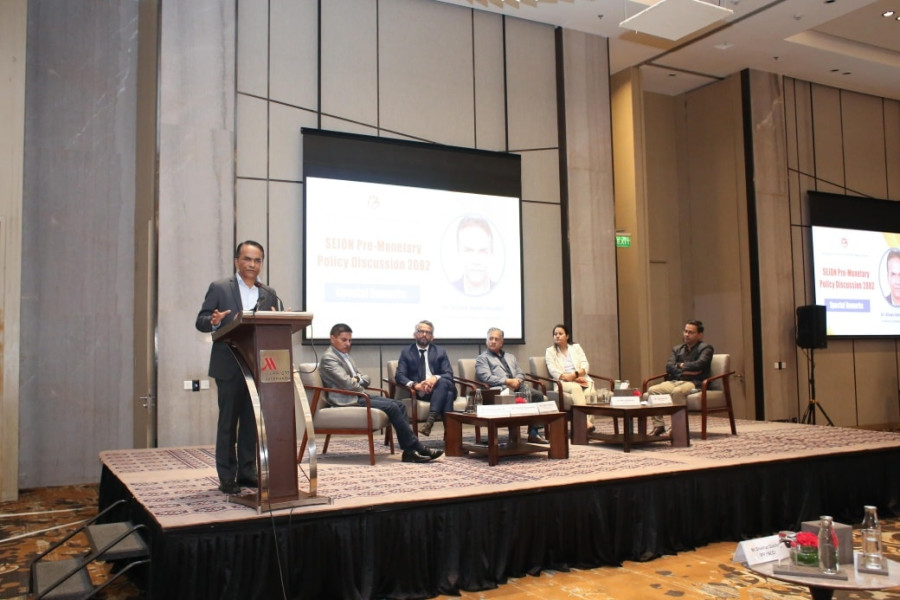Money
Economists warn rising bad loans could threaten financial stability
The IMF, economists stress urgent reforms, asset management companies, and policy coordination amid growing loan defaults.
Post Report
A rise in nonperforming loans (NPLs) could pose serious risks to the economy, economists warned on Sunday.
The number of nonperforming loans typically rises during times of economic uncertainty. These are loans for which borrowers either do not or cannot make payments.
At a pre-monetary policy discussion titled “Tackling Non-performing Loans (NPLs): Role of Monetary Policy in Ensuring Financial Stability”, organised by the Society of Economic Journalists-Nepal in Kathmandu, economist Sameer Khatiwada said that extending loans simply to avoid bankruptcy is not a rational strategy.
“We need to conduct a proper survey,” Khatiwada said. “The government's decision to bring the asset management company into operation is a good move, but more important is to conduct an asset quality review. That will help identify bad assets and make banking transactions more transparent.”
An asset management company is expected to manage banks' and financial institutions' bad loans and non-banking assets. The government is preparing to establish a separate institution dedicated to managing the rapidly increasing volume of bad loans in the financial system.
According to third-quarter financial statements released by 20 commercial banks for the current fiscal year (as of mid-April), the average NPL ratio has climbed to 4.8 percent, up from 3.65 percent during the same period last fiscal year.
By mid-April, NPLs at nine of the 20 commercial banks had exceeded the 5 percent threshold, which financial experts consider unhealthy for the system.
A recently published IMF report has also flagged rising risks in Nepal’s financial sector, noting that nonperforming assets have not been addressed effectively due to a lack of proper restructuring and delays in asset auctions.
While Nepal’s external sector remains strong—with rising exports, tourism receipts, and remittance inflows outpacing import growth—challenges in the financial sector continue to mount.
“Financial sector vulnerabilities have not yet eased,” the IMF warned. “NPLs rose to 5.2 percent as of April 2025, eroding bank capital buffers. The financial condition of savings and credit cooperatives (SACCOs) also remains concerning.”
Khatiwada noted that while the expansionary monetary policy during the Covid-19 pandemic was appropriate, the rollback was abrupt, and interest rates were hiked too quickly.
“Coordination between fiscal and monetary policy is essential,” he said, “as it enables both tools to work in tandem.”
Experts also expressed concern that banks' NPL data may not reflect the actual situation, as figures are often underreported. If loan recovery does not improve in the coming months, many banks could face significant difficulties.
“During the pandemic, monetary policy took on the heavy lifting, which weakened lending standards. Banks started issuing loans easily, ultimately creating the NPL problem,” Khatiwada said.
Nepal Rastra Bank Governor Biswo Nath Poudel stressed the need for a microeconomic approach that considers climate-related vulnerabilities.
“Credit should be directed in a way that it reaches all segments of the population,” Poudel said, adding that rising NPLs in the agriculture and construction sectors must be addressed and corrected.
He acknowledged that while economic indicators show improvement, several pressing issues remain unresolved.
Rajesh Upadhyay, senior vice-president of the Confederation of Banks and Financial Institutions Nepal, pointed out that despite low interest rates, credit flow has declined, which suggests deeper underlying problems.
“The fall in loan demand is largely due to a sharp decline in disposable incomes,” Upadhyay said.
“With falling earnings and a growing number of youths leaving the country for work or education, consumption has dropped.”
He added that borrowers are struggling to manage loans due to the economic slowdown triggered by Covid-19 and the introduction of stricter working capital guidelines. “People are unable to repay their loans even by selling land.”
Economist Menuka Karki said that monetary policy appears to supplement fiscal policy in Nepal.
“The private sector’s problems need to be addressed either by fiscal or monetary policy,” she said. “The core issue is the lack of coordination, and the failure to make fiscal policy expansionary,” Karki added.
The main objectives of monetary policy are to maintain price stability and balance of payments stability.
Santosh Koirala, president of the Nepal Bankers’ Association, said the government should legally mandate the operation of asset management companies.
“While banks have been doing asset management independently, there is a strong need for a separate and empowered asset management institution,” he said.




 18.12°C Kathmandu
18.12°C Kathmandu













